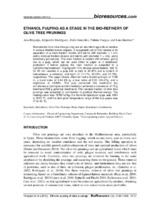Ethanol pulping as a stage in the bio-refinery of olive tree prunings
Autor
Requejo Silva, Ana
Rodríguez Pascual, Alejandro
González, Zoilo
Vargas González, Fátima
Jiménez, Luis
Editor
NC State UniversityFecha
2012Materia
BiorefineryOlive tree prunings
Pulp
Paper
Bioethanol
Combustion
METS:
Mostrar el registro METSPREMIS:
Mostrar el registro PREMISMetadatos
Mostrar el registro completo del ítemResumen
Biomaterials from olive tree pruning are an abundant agricultural residue in various Mediterranean regions. A suggested use of this residue is its separation in a main fraction (trunks and stems with diameter > 1 cm) and a residual fraction (leaves and stems with diameter 1 < cm), using biorefinery procedures. The main fraction is cooked with ethanol, giving rise to a pulp, which can be used either in paper or in bioethanol production if before pulping the main fraction is subjected to a hydrothermal treatment. Pulping with 70% ethanol concentration, 185 °C for 80 min resulted in a pulp with a yield of 46.30% and a content of holocellulose, α-cellulose, and lignin of 77.17%, 62.49%, and 21.73%, respectively. The paper sheets obtained had a breaking length of 1168 m, a burst index of 0.44 kN /g, a tear index of 2.25 mN.m2/g, and a brightness of 43.66%. The pulp converted into bioethanol (by simultaneous hydrolysis and fermentation) achieved a conversion of 70 g bioethanol/100 g potential bioethanol. The residual fraction of olive tree prunings was subjected to combustion to produce thermal energy. The heating value was 18700 kJ/kg, the flame temperature range was 1094 to 2013 ºC, and the dew point temperature range of the flue gases was 47 to 53 °C.

